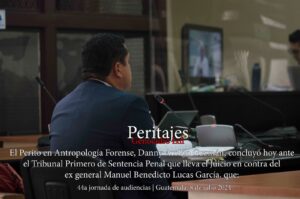
The photograph reads “Peritajes Genocidio Ixil. The expert in forensic anthropology, Danny Aroldo Guzmán, concluded today before the First Court of Criminal Sentence that is conducting the trial against former general Manuel Benedicto Lucas García, that 44th day of hearings, Guatemala July 8, 2024.” Picture by FGER
Monday, July 8, Hearing 44
This week, the delegation of young Guatemalan-Americans continued its presence in the courtroom to show solidarity with the plaintiffs, witnesses and lawyers in the trial. The delegation was organized by CRLN (Chicago Religious Leadership Network on Latin America).
Forensic Anthropology Expert Danny Aroldo Guzmán, appeared to ratify several forensic anthropological expert reports. The expert concluded before the First Criminal Sentencing Court that is conducting the trial against General Manuel Benedicto Lucas García, that several mass graves were found “(…) in the Military Detachment of Xolusinay 81 skeletons were found corresponding to 76 men and 5 women, 13 of which had their hands tied, blindfolded and their mouths covered, which according to the evidence, were executed with firearm projectiles and blunt and sharp weapons in the skull, jaw and thorax. These wounds and other evidence scientifically prove that the victims were executed inside the Military Detachment (…)”.
This detachment was installed in 1982 in the seat of the municipality of San Juan Cotzal. According to ODHAG, this expert corroborates the testimonies of the wives and children who testified during the first weeks of the trial asking for justice. In addition, the expert pointed out that in some of the skeletons found, one could clearly observe the clothing corresponding to the Ixil communities’ clothing. Of this group of skeletons found, 94% of the skeletons were men and 6% were women and he pointed out that 53 victims have already been genetically identified, 50 men and 3 women.
The Judge asked the expert how the skeletons are returned to their families. The expert answered that they are delivered either directly to the relatives or when they are not identified, it is the community that is in charge of making the procedure with the Public Prosecutor’s Office and they bury them in the community, with a code, in boxes properly packed. The expert points out that the clothes, the offerings, and any object that is found is returned to the relatives.
Tuesday, July 9, Hearing 45
The statement of the expert Alma Nidia Vásquez was heard, who ratified several forensic anthropology reports when she worked at the Guatemalan Forensic Anthropology Foundation (FAFG).
In one of the exhumations carried out by the FAFG, 32 skeletons were found, most of them women and children. The victims showed gunshot wounds and signs of having been burned, since the few clothes recovered showed signs of fire. She explained that the cause of death of the identified victims was corroborated and supported by a forensic doctor.
Jaime Ruiz Castellanos, an expert in social anthropology, also appeared before the court and ratified expert reports carried out with the FAFG. One of them was carried out in San Juan Cotzal, Quiché, where a grave with human remains was located. A skeleton was found there and identified as Juan Toma Pérez. The skeleton showed perforations from a firearm. The expert noted that Mr. Toma’s relatives indicated that he was killed by members of the army in March 1982.
He also ratified his expert report carried out on 28-5-2008 in Santa María Nebaj, Quiché. The expert explained that this exhumation was carried out at the request of a relative of 3 victims and pointed out that 2 of the victims died as a result of a bomb explosion. The third, a girl, died of fright due to the stress caused by the constant bombing they suffered while taking refuge in the mountain.
Wednesday, July 10, Hearing 46
Expert witness Marta Casaús Arzú was scheduled to testify on July 10 but was unable to appear because she is undergoing a medical procedure. Her testimony will be rescheduled.
Expert witness Reyna Patricia Ixcot Chávez, forensic anthropologist, ratified expert reports carried out between 2003 and 2007. In Santa Clara Village, Quiché, she found two skeletons: The skeleton identified as Gaspar Cox, with no signs of violence, and the skeleton of Margarita Raymundo, who died in the mountains in 1983 after being displaced in 1981. The prosecutors of the MP pointed out that this fact, among others, is part of the accusation of the crime of genocide constituted by death by subjection to conditions.
From the expert examinations carried out in San Juan Cotzal, Quiché, the remains of a child between 2 and 3 years old were found, without determining the cause of death, and the skeleton of a man between 30 and 40 years old, identified as Cirilo Salas. The expert explained that although the sex or cause of death of the child could not be determined by her evaluation, the porosity of the bones of a child distinguishes it from an adult.

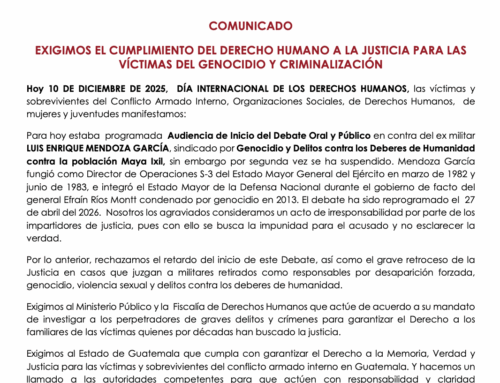
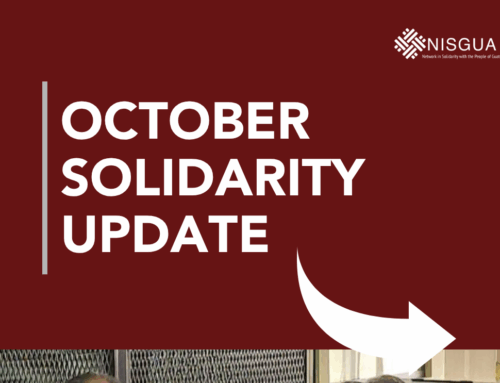
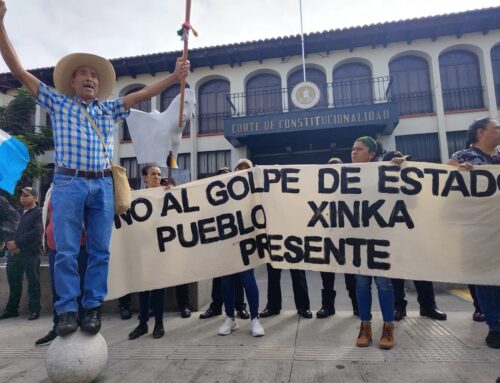
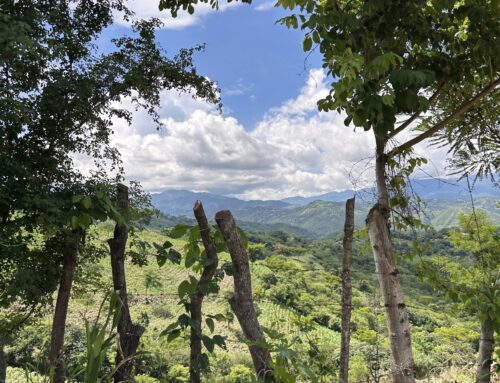
Leave A Comment